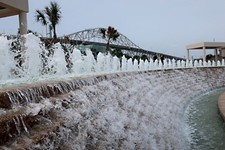Day Trips
By Gerald E. McLeod, Fri., Nov. 15, 2002

The Barton Warnock Environmental Education Center outside of Lajitas officially serves as the eastern gateway to the Big Bend Ranch State Park, but it makes the perfect introduction to the entire Big Bend region even though it is nearly 100 miles inside the great curve of the Rio Grande.
The Big Bend area is one of the most diverse regions in a state that prides itself for being a land of contrasts. Although a good 80% of the territory is the scrub-brush land of the Chihuahuan Desert, there are also fertile grasslands, desert springs, and wetlands, woodlands of oak and pinyon, and the conifer forests of the higher elevations in the region. It is a complex and beautiful place where a single visit can seldom encompass it all and is never enough.
The massiveness of the area is why the Barton Warnock Center is the perfect place to begin a journey to the land of mysterious lights and endless horizons. The colorful exhibits in the interpretive center, titled "Una Tierra -- One Land," trace the archeological, geological, historical, and natural stories of a 44,000-square-mile region. Although the U.S. Border Patrol has closed the crossing at Lajitas to migrant workers and tourists, science does not always recognize political borders, and two-thirds of the area documented in the museum panels extend into Mexico.
The centerpiece of the exhibit is a room-sized topographic map that shows the contour of the land marked by mountain ranges, scarred by dry arroyos, and swept smooth by winds. The map offers a bird's-eye view of the giant caldron that is Big Bend. Understanding the lay of the land is the first step in comprehending the uniqueness and beauty of this vast area.
The galleries in the center take the visitor through the five biological regions as well as document the strength and perseverance of the people who have inhabited the land for centuries. The desert may be harsh, but it is also fragile, and modern man's mistakes can take years to heal. The panels don't ignore the damage caused by ignorant or uncaring immigrants who sought to exploit the region's resources.
The American Indians had a legend that said when the Great Spirit finished making the earth he dumped the leftovers in the Big Bend area. A geological storybook, the land was shaped by volcanoes and a vast shallow ocean, which once covered much of Texas. Despite averaging less than 10 inches of rain a year, the region's rocky soil supports more than 1,000 species of plants, of which more than 200 are edible.
Naming the visitor center for Dr. Barton H. Warnock was a fitting tribute to a man who devoted his life to collecting and protecting the plants of the Trans-Pecos region of Texas. The renowned botanist died of an apparent heart attack in 1998 after a 33-year teaching career at Sul Ross State University in Alpine. Not only did he discover many undocumented plant specimens, he also taught several generations how to manage the fragile land.
A large portion of the Warnock Center is dedicated to a garden of desert plants, some of them collected and cataloged by Dr. Warnock and named after him. In the shadow of the Lajitas Peak, the center was built as the Lajitas Museum Desert Gardens in 1982 by resort developer Walter Mischer with technical assistance from Dr. Warnock. In 1990, Texas Parks and Wildlife bought the property as the entrance to the Big Bend Ranch State Park, a two-and-half-hour drive up the river.
The Barton Warnock Environmental Education Center opens daily from 8am to 4:30pm. Admission to the exhibit is $3 for adults and $1.50 for children. The ranger station in the center also sells permits for the state park, back country use permits, and Rio Grande canoeing permits.
Accommodations are available 17 miles away in Study Butte or, for more expensive tastes, in Lajitas. Besides camping, Big Bend State Park offers rooms in the Sauceda "Big House," the former ranch family's home for $40 per person or in the dormitory-style bunkhouse for $15 per person. For more information call 915/424-3327 or visit www.tpwd.state.tx.us.
597th in a series. Day Trips, Vol. 2, a book of Day Trips 101-200, is available for $8.95, plus $3.05 for shipping, handling, and tax. Mail to: Day Trips, PO Box 33284, South Austin, TX 78704.Jewel at Lajitas Peak








